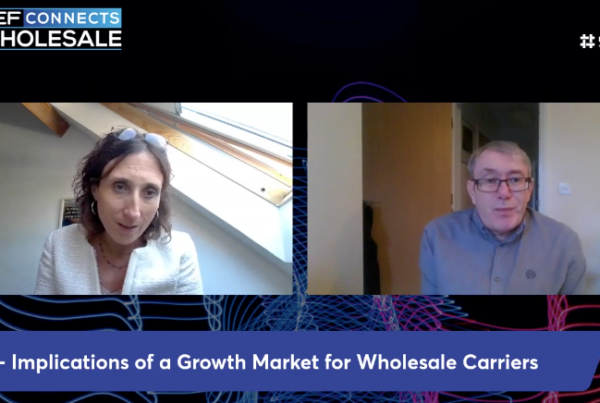MEF IoT Project Director Nassia Skoulikariti recently gathered a stellar lineup of expert speakers to celebrate Women’s History month and talk about the important role of Customer Experience. Here she shares an overview of the discussion and the key takeaways from the debate.
Customer experience, or CX, is the process of creating a positive relationship with customers. Businesses need to create a CX strategy to help them retain customers and grow their business.
Today, many companies have embraced a customer-centric approach. The goal of customer-centric companies is to make it easy for customers to get information, buy and receive support when, where and how they need it and keep them happy. Your customers go online and search for answers. They ask friends and colleagues. They want answers quickly; they expect you as a company to provide fast, easy, and integrated solutions.
On March 31st, I was joined by 8 accomplished women from the Technology and Telco worlds to celebrate Women’s History month and talk about Customer Experience.
- Raluca Berchiu, Customer Experience Strategist at CX Decoded
- Arim Akeh-Osu, Manager International Roaming & Wholesale Negotiations at MTN
- Virginie Debris, Chief Product Officer at GMS
- Sonia Kaul, VP Product Marketing & Business Development at Karix
- Sharon Boyd, Chief Customer Experience Officer at METAB3E
- Valentina Dal Borgo, Sales DirectorConnectivity, IDC, IPT/DIA, Mobility, Messaging and IoT at CMI
- Catherine Maquire, Product Manager at BT
- Sneha Shashi Kumar, Lead Product Marketing at Route Mobile Ltd
What is Customer Experience?
Customer experience is the totality of a customer’s interactions with a company or product. It encompasses everything from the moment a customer interacts with a business online to the delivery and installation of a product. It can also encompass how customers are treated after they’ve made a purchase, as well as their overall satisfaction with the company or product.
“It’s the holistic approach to the customer lifecycle, from the before the sales to the experience the customer has with the products, with the services to the experience, that when they need the support of the company, to loyalty and the lifetime value to better explain what customer experiences is to understand that what means creating value for others. It’s the essence of every successful business or career… So overall, customer experience is about the engagement, the loyalty, and the trust you have with the person.” Raluca Berchiu
The right pieces of tech need to be deployed which can really take data from all the different sources and then bring it into a unified kind of a warehouse… They’re personalised. They are contextual… technology has to be used correctly to be able to drive these omnichannel kinds of customer experiences…“
Customer experience is an important part of any company’s strategy because it can impact how customers perceive the company and its products. If customers have negative experiences, they may be less likely to return or recommend the company to others. Conversely, if companies make it easy for customers to find what they’re looking for and communicate effectively with them, they’re more likely to convert leads into sales and satisfy customers.
Why Is Customer Experience Important?
Customer experience is one of the most important factors in a data-driven world. Customers are increasingly using technology to interact with businesses, and they expect seamless experiences when doing so.
Poor customer experiences can lead to negative customer sentiment, decreased sales, and even lost customers. By understanding and optimizing the customer experience, businesses can create a positive relationship with their customers and increase overall profitability.
“Products and services are built for consumers so there’s no surviving business without them. Right now, customer experience encompasses every aspect of that journey of whatever the company’s offering is, whether it’s the customer service itself, whether it’s the packaging, the brand, the advertising, the ease of use, how reliable the product or the offering is it’s all that so experience simply is just how the customer feels about your offerings and what you put out there to them.” Atim Akeh-Osu
The difference between Customer Support and Customer experience.
Customer support is a term used to describe the activities and services companies offer their customers to resolve problems, provide feedback, and otherwise improve customer satisfaction. Customer experience, on the other hand, is a term used to describe the overall relationship between a customer and a company. It encompasses customer support and the entire customer experience journey, from first contact with a company through repeat business.
“Customer support is related to a specific event, is a reaction to a problem and how the company responds to the problem towards the customer, and it needs to be resolved in the immediate. Customer experience is the whole life cycle of the customer.. it starts with the marketing, and it finishes with the post-sales.” Valentina Dal Borgo
“Customer support is more reactive, whereas customer experience is more a proactive experience. The goal of customer experience in many cases is to avoid customers having to contact customer service. “Sneha Shashi Kumar
How Can Businesses Create A CX Strategy?
In a data-driven world, customer experience (CX) is becoming increasingly important. By understanding and anticipating customer needs, businesses can create a CX strategy that meets their customers’ expectations.
Here are four tips for creating a successful CX strategy:
1. Identify your customers’ needs.
Before creating effective Cx strategies, you first need to know what your customers want and need. Use surveys, focus groups, and other research methods to get an accurate understanding of your customers’ wants and needs. Once you know what they want, you can begin to develop solutions that meet their needs.
2. Build customer relationships
With so much data available, businesses must build strong customer relationships to stay ahead of the competition. By understanding customers’ needs and providing them with the best possible experience, businesses can keep coming back for more.
“It’s a matter of responsibility without an organisation; each organisation is responsible for managing the customer experience end to end, from the marketing is being published to the services that they sell, to the type of people they hire and to their post-sales and what’s up and next and also the vision for the future, the message that they’re giving out there.” Valentina Dal Borgo
” I work in the messaging space and I work with big brands to build out really good customer service diversion campaigns for customers, where we can meet the customer in the most seamless way, where they don’t have to contact a brand and they don’t have that negative experience that will ruin that customer experience and drive down brand loyalty and cause churn for a brand.” Catherine Maquire
3. Identify and address customer pain points early and often.
By understanding and addressing customer pain points early and often, businesses can create a positive relationship with their customers and increase loyalty. This ultimately leads to increased sales and improved productivity.
“Customer recovery can be really tough. It’s one of almost the lowest point for most customers. But it can also be that point where you can flip it on its head and really delight a customer and build those strong, loyal bonds if you can build it into a place of delight” Sharon Boyd
4. Use technology to enhance the customer experience
“You’ve got to get your systems right to empower the frontline so they have visibility and they can respond back to the latest piece… It’s making sure the data is presented in the right way. So it’s quick for all to access.” Sharon Boyd
In today’s data-driven world, technology can be used to enhance the customer experience in many ways. For example, online ticketing systems can help customers purchase tickets quickly and easily, while social media platforms and chatbots can provide customers with real-time updates on events. By using technology to improve the customer experience, businesses can create a more positive relationship with their customers and build trust.
“The right pieces of tech need to be deployed which can really take data from all the different sources and then bring it into a unified kind of a warehouse or a data Lake from where you can actually then target and really build profiles of customers where experiences that you are able to deliver really makes sense. They’re personalised. They are contextual… technology has to be used correctly to be able to drive these omnichannel kinds of customer experiences… they cannot be disjointed. I cannot be saying something else on a bot and I cannot be saying something else on my web or a mobile app. It all has to come together.” Sonia Kahul
“This interaction with the customer is really what is important and that’s where you need those kind of Cpass, multi channel only channel, whatever the way you call those platforms.” Virginie Debris
What Are The Benefits Of Having A Good CX Strategy?
A good customer experience strategy can provide several benefits for businesses.
First and foremost, a good customer experience strategy can help businesses attract and retain customers. It can also help businesses improve customer satisfaction levels, leading to increased loyalty and sales. In addition, a good customer experience strategy can help businesses reduce churn rates – which is especially important in today’s data-driven world. Finally, a good customer experience strategy can also help businesses improve their image overall.
“Customer experience is not only about resolving the problems of the customer, it’s also anticipating them and being able to elevate them.” Ralucaa Berchiu
“You really need people to feel special. You really need to reach out to the end-user at the right time, in the right place, using the right channel. ” Virginie Debris
“Businesses today are realising how important it is for them to delight and serve their customers at every touch point in the customer journey. I would typically classify these moments, I would like to call them as customer moments that matter. And during these crucial moments, if the businesses are not available to the customer, there are high chances that it can lead to frustration. Sometimes they can quietly switch off to another brand, just like with a snap of a finger.” Sneha Shashi Kumar
Conclusion:
Customer experience is essential for any business that wants to succeed. By creating a cx strategy, businesses can improve the customer experience and increase their chances of success.
The key to creating satisfied customers is building strong relationships with them.
In closing, I would like to thank our wonderful speakers for their insights and participation to this webinar. If you would like to know more about our future events do get in touch!





